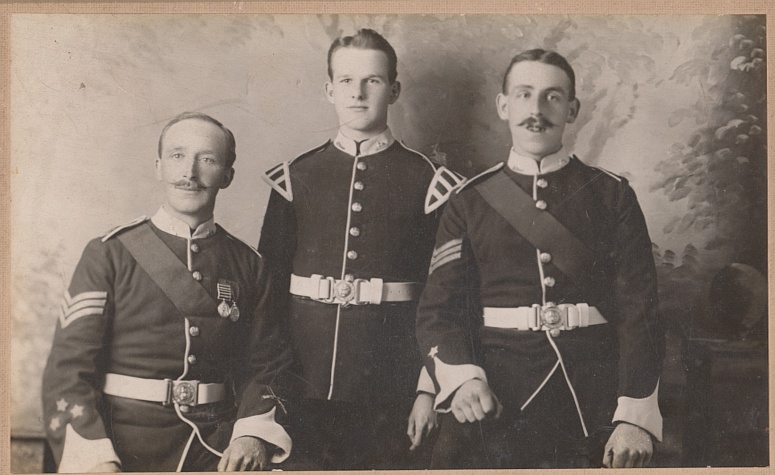
Three members of the same family served with the Lincolnshire Regiment. Seth William George Howson served with the regiment and received both the Queens South Africa and the Kings South Africa medals for his service during the South African Wars 1899-1902. He survived and is listed as living in Lincoln in 1911 along with his wife Elizabeth and his two sons George William and Arthur Balfour. Both his sons served with the Lincolnshire Regiment during the First World War.
Sgt George William Howson, the elder son, worked as a labourer and painter prior to joining the war effort. He served with C Coy of the 1st and 4th Battalions of the Lincolnshire Regiment. Sadly he was killed on 13th October 1915. He was awarded the Victory Medal and the British War Medal posthumously and his effects were left to a Miss Sarah Ann Petty. We do not know how Miss Petty and George were related; was she a family relation or a future wife?
CSM Arthur Balfour Howson MM survived the war and was awarded a Military Medal and a silver war badge in addition to the First World War medal trio. The Military Medal was awarded for bravery in battle, but no citation survives to describe the specific action for which Arthur received his. Aged 23, Arthur married Emma Eliza Stanford in 1916 in Lincoln. He worked in the manufacturing sector after the war, and is listed as in charge of Stationery & Mailing depots on the 1939 Register.
Arthur died in 1973 at Friesthorpe House, Lincolnshire aged 80.
Explore more memories from the ribbon
-
Thomas Outhwaite
The Outhwaite family came to live in Stalling Busk in the Raydaleside area near Bainbridge in the 1730s to farm the land. Thomas’s father William had married Eleanor Pickard, a girl from Newbiggin near Aysgarth. They later lived for a time at Ingleton in the Dales where Thomas was born in 1880. Thomas would be one of 6 children. Shortly after 1880 they moved back to Stalling Busk. Thomas’s father eventually became the gamekeeper on the estate of Colonel Percy Williams, MP, of Raydale Grange. In 1905 Thomas’s brother William took over the Rope works in Hawes, which still operates today under the Outhwaite name. By now Thomas had married Gertrude Sherrington, a girl from Tunstall near Catterick and was working with his father on the Raydale Estate. Thomas enlisted in 1915 joining the 9th Battalion Yorkshire Regiment. It was during The Battle of Messines in June 1917 that on the 19th Private Thomas Pickard Outhwaite was wounded, he died of his wounds later that day. He is buried at the Military Cemetery in Poperinge.
-
Jack Charlton
Sergeant John (Jack) Charlton joined the Army as a Territorial in 1908 when he enlisted in the 4th Battalion, Alexandra, Princess of Wales’ Own Yorkshire Regiment (The Green Howards). He served on the Western Front from April 1915 where he had a distinguished career, earning a Distinguished Conduct Medal and being Mentioned in Despatches in 1917. One particular act stands out from his memoirs which earned him a commendation from his Commanding Officer was while serving at the Arras Front while he was in charge of Battalion communications. After heavy shelling cut phone lines he used a Lucas Day Light Signalling Lamp to request an artillery barrage to defend the HQ from German gas shells. This Lamp was donated to the Museum and can be seen on display. Jack also suffered injuries during his service, firstly in April 1915 when he was gassed at Zillibeck and another, more serious gas attack got him sent home towards the end of 1917 where he remained for the rest of the War. While on Leave in 1916 Jack got engaged to Phillis Blow but they didn’t get married until 1918 after we was sent home. During 1918 he attended various training courses including a Signals Course at the Armoury School near Dunstable but before he was able to finish the Armistice was signed and so he was demobbed at Hornsea.
-
William Hird
William Hird was nominated for the Ribbon of Remembrance by Dianne Evans, and his story illustrates a problem that can occur with records that are a century old. Thanks to the original 1914-16 enlistment leger at the Green Howards Museum, we can say with some confidence that William enlisted on 10th December 1914 in the City of Durham and that he was posted to the 3rd Battalion, based at West Hartlepool on 18th January 1915. According to his medal card 18390 Acting Lance Corporal William Hird served in France from 19th September 1915, and was entitled to the 1915 Star, the British War Medal and the Victory Medal. William is recorded on the ‘Soldiers died in the Great War 1914-1919’ database as having died on 29 September 1916 as a Private in the 7th Battalion of the Yorkshire Regiment. This might have been the case, but on examining the battalion war diary, the 7th Battalion were away from the frontline in training and there are no records of any deaths that day. Of course soliders would often die from wounds days after an offensive, however the Green Howards Gazzette for December 1916 records that 18390 W Hird was Killed in Action – there is a separate list for those who Died of Wounds. On further investigation, the Register of Soldier’s Effects lists William as being in the 6th Battalion when he was killed in action in France. The war diary of 6th battalion recounts the attempted assault on ‘Stuff Redoubt’…
